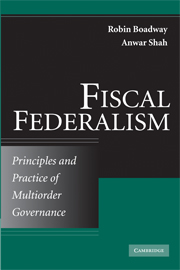Book contents
- Frontmatter
- Contents
- Preface
- PART ONE DESIGNING FISCAL CONSTITUTIONS
- PART TWO REVENUE SHARING AND FISCAL TRANSFERS
- PART THREE FINANCE AND PROVISION OF PUBLIC SERVICES
- PART FOUR CHALLENGES AND RESPONSES
- 14 Fiscal Federalism and Macroeconomic Governance
- 15 Interregional Competition and Policies for Regional Cohesion and Convergence
- 16 Decentralized Governance and Corruption
- 17 Adapting to a Changing World
- References
- Index
15 - Interregional Competition and Policies for Regional Cohesion and Convergence
Published online by Cambridge University Press: 05 June 2012
- Frontmatter
- Contents
- Preface
- PART ONE DESIGNING FISCAL CONSTITUTIONS
- PART TWO REVENUE SHARING AND FISCAL TRANSFERS
- PART THREE FINANCE AND PROVISION OF PUBLIC SERVICES
- PART FOUR CHALLENGES AND RESPONSES
- 14 Fiscal Federalism and Macroeconomic Governance
- 15 Interregional Competition and Policies for Regional Cohesion and Convergence
- 16 Decentralized Governance and Corruption
- 17 Adapting to a Changing World
- References
- Index
Summary
Competition among governments at the same level or with similar responsibilities is commonly referred to as horizontal competition or interjurisdictional competition in the literature on economics and political science. A related concept of intergovernmental or vertical competition refers to competition among governments with different levels and types of responsibilities, for example, among federal, state, and local governments. Our concern in this chapter is with the interjurisdictional competition (interregional or local-local competition) alone and its implications for the federal government's role in securing an economic union or an internal common market.
Competition among state and local governments is quite commonplace in most federal systems. It occurs through lobbying for employment generation and against hazardous waste location of federal or private-sector projects, including military bases; encouraging foreign and domestic investment; and providing incentives and subsidies for attracting capital and labor, public infrastructure to facilitate business location, a differentiated menu of local public services, one-stop windows for licensing and registration, and endless other ways of demonstrating an open-door policy for new capital and a skilled work force. State and local governments also compete among themselves in erecting barriers to trade and tariff walls to protect local industry and business. They also compete among themselves in exporting tax burdens to non-residents where feasible.
This chapter examines the pros and cons of interjurisdictional competition in a federal system and examines the ways the federal government can play a supporting role to accentuate the positive aspects of this competition while dealing with any negative fallout of unbridled competition.
- Type
- Chapter
- Information
- Fiscal FederalismPrinciples and Practice of Multiorder Governance, pp. 498 - 516Publisher: Cambridge University PressPrint publication year: 2009



